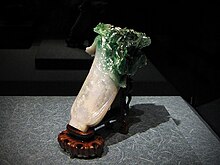Now, a brief history is presented here on the construction of this palace. When the Mongols ruled China during the Yuan dynasty from 1271 to 1368, they established the capital here but it was called Dadu 大都 at that time. The Yuan dynasty lasted less than a hundred years before it was overthrown by the Han Chinese under the leadership of Zhu Yuanzhang (朱元璋) and the Ming dynasty was established, the capital was then shifted to south to Nanjing and the palace built by the Mongols was burnt down by the first Ming emperor (Hongwu Emperor). However, it was during the reign of the third Emperor of Ming, Zhu Di ( Hongwu 's fourth son, also known as Yongle Emperor) who shifted the capital back to Beijing after realising the strategic importance of the city. This was after Zhu Di seized the throne from his nephew (the son of Hongwu 's crown prince who died before taking over the throne) after a 4 year civil war. At that time, the threat from foreign invasion was from the North, hence it was important to station troops and state administration in Beijing to safeguard the interest of the empire. So Zhudi planned to shift the capital to the north, to Beijing. Although most court officials were against the idea of shifting the capital (a waste of useful resources), he refused to listen to their advice and ordered the construction of this huge palace in 1406. It took 14 years before construction was finally completed in 1420 and this palace is what we know today as the Forbidden city.
 |
| Inside the Palace |
 |
| The Front View |
Do you know, a total of 24 emperors from the Ming and Qing dynasties lived in the Forbidden City. With the abdication of Puyi, the last Emperor of China after the revolution in 1911, he was allowed to stay in the inner court of the palace where the outer court was assigned for public use. Puyi was finally evicted from the palace in 1924 and the Palace Museum was formed in 1925 to take over the administration of the Forbidden City. The Palace Museum houses the national treasures from the Ming and Qing era and for the first time ordinary citizens were allowed entry to the Forbidden City to view the valuable exhibits. With the invasion by the Japanese army in 1933, the national treasures were force to evacuate the museum.
The Forbidden City was declared a World Heritage Site in 1987, and is listed by UNESCO as the largest collection of preserved ancient wooden structures in the world. Since 1925, the Forbidden City has been under the charge of the Palace Museum, whose extensive collection of artwork and artifacts were built upon the imperial collections of the Ming and Qing dynasties. Part of the museum's former collection is now located in the National Palace Museum in Taipei. Both museums descend from the same institution, but were split after the Chinese Civil War. After the war, the Forbidden City was under major repair to restore the palace to its original condition.
 |
| View taken from a park on a hill facing the palace |
 |
| A Jade Mirror |
 |
| Jade Cabbage, in Taipei Museum |
假期相约来北京
中国古都好风景
未登长城非好汉
不游故宫枉此行
For more infomation on the Ming Dynasty: http://en.wikipedia.org/wiki/Ming_Dynasty
The Imperial Palace or Forbidden City: http://en.wikipedia.org/wiki/Forbidden_City
The Yuan Dynasty: http://en.wikipedia.org/wiki/Yuan_Dynasty
For more infomation on the Ming Dynasty: http://en.wikipedia.org/wiki/Ming_Dynasty
No comments:
Post a Comment